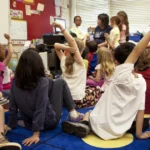Support our educational content for free when you buy through links on our site. Learn more
What Are the 8+ Teaching Approaches You Need to Know in 2025? 🎓
Have you ever wondered why some lessons stick like glue while others drift away like a forgotten daydream? The secret often lies in the teaching approach — that magical method that turns information into understanding, boredom into curiosity, and classrooms into thriving learning communities. While many search for the “5 teaching approaches,” the reality is richer and more exciting: there are at least eight powerful strategies every educator should master to meet the diverse needs of today’s learners.
In this article, we unravel these essential teaching approaches — from the classic Direct Instruction to the tech-savvy Flipped Classroom and beyond. We’ll explore how blending these methods can transform your classroom, boost student engagement, and prepare learners for the challenges of tomorrow. Plus, we’ll share real stories, expert tips, and a sneak peek into the future of education that will keep you inspired and ready to innovate.
Key Takeaways
- There’s no one-size-fits-all: Mastering multiple teaching approaches lets you tailor instruction to diverse learners and contexts.
- Top approaches include Direct Instruction, Inquiry-Based Learning, Collaborative Learning, Differentiated Instruction, Flipped Classroom, Project-Based Learning, Experiential Learning, and Blended Learning.
- Technology plays a transformative role in enabling flipped and blended models, but equity and access remain critical considerations.
- Balancing teacher-centered and student-centered methods creates the most effective and engaging classrooms.
- Real-world success stories prove these approaches work — from boosting reading scores to sparking community activism.
Ready to level up your teaching toolkit? Explore resources like Khan Academy, Google Classroom, and Seesaw to integrate these approaches seamlessly.
👉 Shop educational tools on:
Table of Contents
- ⚡️ Quick Tips and Facts
- Unpacking Pedagogy: A Brief History of Teaching Approaches and Learning Theories
- Why Understanding Diverse Teaching Approaches Matters for Every Educator 🍎
- The Magnificent Eight (Plus!): Core Teaching Approaches Every Educator Should Master
- The Direct Instruction Approach: The “Sage on the Stage” 🎤
- The Inquiry-Based Learning Approach: Igniting Curiosity and Critical Thinking 🔥
- The Collaborative Learning Approach: Power in Numbers and Peer Interaction 🤝
- The Differentiated Instruction Approach: Tailoring Education for Every Unique Learner 🧵
- The Flipped Classroom Approach: Homework in Class, Lectures at Home 🔄
- The Project-Based Learning (PBL) Approach: Real-World Challenges, Real-World Solutions 🏗️
- The Experiential Learning Approach: Learning by Doing and Reflecting 🤸♀️
- The Blended Learning Approach: The Best of Both Worlds with Digital Integration 💻
- Beyond the Big 8: Other Influential Pedagogical Strategies and Models to Explore
- Teacher-Centered vs. Student-Centered: A Pedagogical Tug-of-War and How to Balance It ⚖️
- Choosing Your Superpower: Selecting the Right Teaching Approach for Your Classroom Context 🎯
- Navigating the Challenges and Reaping the Rewards of Diverse Teaching Approaches 🎢
- Technology’s Transformative Role in Modern Teaching Approaches and Instructional Design 🤖
- Common Misconceptions About Teaching Methodologies and Effective Pedagogy 🚫
- Real-World Impact: Success Stories from Diverse Classrooms and Innovative Educators 🌟
- The Future of Education: Evolving Teaching Approaches for Tomorrow’s Learners 🚀
- Conclusion: Your Pedagogical Toolkit Awaits! 🛠️
- Recommended Links for Deeper Learning 🔗
- FAQ: Your Burning Questions About Teaching Approaches Answered! 🤔
- Reference Links 📚
⚡️ Quick Tips and Facts
Before we dive into the rich world of teaching approaches, here’s a quick snapshot to get your pedagogical engines revving:
- There isn’t just one “best” teaching approach — the magic lies in knowing when and how to use each.
- The classic “5 teaching approaches” often cited are just the tip of the iceberg; modern educators blend and adapt many strategies.
- Constructivism, Inquiry-Based Learning, Collaborative Learning, Differentiated Instruction, and Direct Instruction frequently top the list.
- According to Hanover Research, 21st-century skills like critical thinking, creativity, and collaboration are driving pedagogical innovation.
- Culturally responsive teaching is a must-have lens to make approaches truly effective for diverse classrooms (Northeastern University).
- Co-teaching models add a powerful collaborative dimension to instruction, especially in inclusive settings (State Education Resource Center).
Want to master these approaches? Check out our 15 Powerful Teacher Collaboration Strategies You Need to Know! 🚀 to see how teamwork supercharges teaching.
Unpacking Pedagogy: A Brief History of Teaching Approaches and Learning Theories
Teaching approaches didn’t just pop out of thin air — they evolved alongside educational philosophy, psychology, and society’s needs.
The Roots of Modern Teaching Approaches
- Constructivism emerged in the early 20th century with theorists like Jean Piaget and Lev Vygotsky, emphasizing learners as active meaning-makers.
- The Direct Instruction model, popularized mid-century by Siegfried Engelmann, focused on clear, explicit teaching — think “teacher as expert.”
- The rise of Inquiry-Based Learning and Collaborative Learning in the late 20th century responded to calls for critical thinking and social skills.
- More recently, Differentiated Instruction and Blended Learning have addressed the needs of diverse learners and technology integration.
Why History Matters
Understanding this evolution helps you appreciate why no single approach fits all classrooms. It’s like knowing the ingredients before cooking a gourmet meal — you can mix and match for the perfect recipe.
For a deeper dive into instructional strategies, visit our Instructional Strategies category.
Why Understanding Diverse Teaching Approaches Matters for Every Educator 🍎
Imagine trying to fix a car with only a hammer. That’s what teaching feels like without a toolkit of approaches. Each student is unique, and so is each learning moment.
Benefits of Mastering Multiple Approaches
- Increased student engagement: Different approaches tap into varied learning styles and interests.
- Better accommodation of diverse learners: From English Language Learners to gifted students, flexibility is key.
- Enhanced critical thinking and collaboration: Approaches like inquiry and collaborative learning foster these 21st-century skills.
- Improved teacher satisfaction and effectiveness: Variety keeps teaching fresh and responsive.
Our educators at Teacher Strategies™ have seen classrooms transform when teachers embrace multiple approaches — it’s like switching from black-and-white TV to full-color HD!
The Magnificent Eight (Plus!): Core Teaching Approaches Every Educator Should Master
Ready for the main event? Here are the 8 powerhouse teaching approaches you’ll want in your pedagogical arsenal — plus a bonus or two!
1. The Direct Instruction Approach: The “Sage on the Stage” 🎤
Direct Instruction (DI) is the classic, teacher-centered approach where clarity and structure reign supreme.
| Aspect | Rating (1-10) |
|---|---|
| Clarity of Objectives | 9 |
| Student Engagement | 6 |
| Flexibility | 5 |
| Effectiveness for Novices | 9 |
| Suitability for Large Classes | 8 |
How it works: The teacher delivers clear, sequenced lessons with guided practice and immediate feedback. Think of it as a well-rehearsed play where the teacher directs every scene.
Benefits:
✅ Efficient for teaching foundational skills (e.g., phonics, math facts).
✅ Easy to measure progress with frequent assessments.
✅ Great for classrooms needing structure and routine.
Drawbacks:
❌ Can feel rigid or boring if overused.
❌ Less opportunity for student creativity or collaboration.
Real-world tip: Our teacher Jane shared, “When I used DI for teaching multiplication, my struggling students finally caught up — but I always mix in group projects to keep things lively.”
2. The Inquiry-Based Learning Approach: Igniting Curiosity and Critical Thinking 🔥
Inquiry-Based Learning (IBL) flips the script: students ask questions and explore answers, developing deeper understanding.
| Aspect | Rating (1-10) |
|---|---|
| Student Engagement | 9 |
| Critical Thinking | 10 |
| Teacher Control | 4 |
| Preparation Time | 7 |
| Suitability for All Ages | 8 |
How it works: Teachers pose open-ended questions or problems. Students research, hypothesize, experiment, and present findings.
Benefits:
✅ Builds lifelong learning skills.
✅ Encourages curiosity and ownership.
✅ Supports differentiated pacing.
Drawbacks:
❌ Requires skilled facilitation.
❌ Can be time-consuming and unpredictable.
Pro tip: Blend IBL with scaffolding techniques to guide students without stifling creativity. Check out our Lesson Planning category for scaffold templates.
3. The Collaborative Learning Approach: Power in Numbers and Peer Interaction 🤝
Collaboration isn’t just for boardrooms — it’s a classroom superpower.
| Aspect | Rating (1-10) |
|---|---|
| Social Skills Development | 10 |
| Student Engagement | 9 |
| Classroom Management | 6 |
| Assessment Complexity | 5 |
| Inclusivity | 8 |
How it works: Students work in pairs or groups to solve problems, complete projects, or discuss topics.
Benefits:
✅ Enhances communication and teamwork skills.
✅ Allows peer teaching and support.
✅ Builds community and reduces isolation.
Drawbacks:
❌ Can lead to off-task behavior if not monitored.
❌ Unequal participation can frustrate some students.
Teacher Strategies™ insight: Use clear roles and rubrics to keep groups on track. For more, see our Classroom Management tips.
4. The Differentiated Instruction Approach: Tailoring Education for Every Unique Learner 🧵
Differentiation is the art of meeting each student where they are.
| Aspect | Rating (1-10) |
|---|---|
| Personalization | 10 |
| Teacher Workload | 7 |
| Student Engagement | 9 |
| Assessment Variety | 8 |
| Resource Intensity | 6 |
How it works: Teachers modify content, process, products, or learning environment based on student readiness, interests, or learning profiles.
Benefits:
✅ Addresses diverse needs in inclusive classrooms.
✅ Boosts motivation by connecting to interests.
✅ Encourages autonomy.
Drawbacks:
❌ Can be overwhelming without planning tools.
❌ Requires ongoing assessment and flexibility.
Our educators recommend: Use tech tools like Google Classroom or Seesaw to organize differentiated tasks efficiently. Explore our Differentiated Instruction category for practical guides.
5. The Flipped Classroom Approach: Homework in Class, Lectures at Home 🔄
Flip the traditional model and watch engagement soar!
| Aspect | Rating (1-10) |
|---|---|
| Student Autonomy | 9 |
| Use of Technology | 8 |
| Teacher Preparation | 8 |
| Classroom Interaction | 9 |
| Accessibility | 6 |
How it works: Students watch lectures or review content at home; class time is for exercises, discussions, and projects.
Benefits:
✅ Maximizes active learning during class.
✅ Allows personalized teacher support.
✅ Encourages self-paced learning.
Drawbacks:
❌ Depends on students’ access to technology.
❌ Requires student accountability outside class.
Pro tip: Use platforms like Khan Academy or Edpuzzle to create or assign videos. See our Instructional Coaching category for tips on guiding students through flipped learning.
6. The Project-Based Learning (PBL) Approach: Real-World Challenges, Real-World Solutions 🏗️
PBL turns classrooms into innovation labs.
| Aspect | Rating (1-10) |
|---|---|
| Engagement | 10 |
| Critical Thinking | 10 |
| Collaboration | 9 |
| Time Investment | 7 |
| Assessment Complexity | 6 |
How it works: Students work on extended projects addressing authentic problems, culminating in presentations or products.
Benefits:
✅ Develops problem-solving and communication skills.
✅ Connects learning to real life.
✅ Encourages creativity and persistence.
Drawbacks:
❌ Requires careful planning and resources.
❌ Can be challenging to assess individual contributions.
Teacher Strategies™ anecdote: “Our science teacher’s PBL unit on local environmental issues sparked student activism — talk about learning with impact!”
7. The Experiential Learning Approach: Learning by Doing and Reflecting 🤸♀️
Experience is the best teacher — and reflection seals the deal.
| Aspect | Rating (1-10) |
|---|---|
| Engagement | 9 |
| Retention | 9 |
| Reflection | 10 |
| Preparation | 7 |
| Adaptability | 8 |
How it works: Students engage in hands-on activities followed by guided reflection to deepen understanding.
Benefits:
✅ Makes abstract concepts tangible.
✅ Supports diverse learning styles.
✅ Builds metacognitive skills.
Drawbacks:
❌ May require special materials or settings.
❌ Reflection time can be overlooked.
Tip: Use journals or group discussions to facilitate reflection. Check out our Instructional Strategies for reflection techniques.
8. The Blended Learning Approach: The Best of Both Worlds with Digital Integration 💻
Blended learning marries face-to-face instruction with online resources.
| Aspect | Rating (1-10) |
|---|---|
| Flexibility | 9 |
| Student Engagement | 8 |
| Technology Dependence | 7 |
| Teacher Preparation | 7 |
| Accessibility | 6 |
How it works: Combines traditional classroom methods with digital tools like learning management systems (LMS), apps, and multimedia.
Benefits:
✅ Personalized pacing and content.
✅ Access to rich, diverse resources.
✅ Supports flipped and differentiated models.
Drawbacks:
❌ Digital divide issues.
❌ Requires tech-savvy teachers and students.
Popular platforms: Google Classroom, Canvas, Schoology, and Edmodo.
Beyond the Big 8: Other Influential Pedagogical Strategies and Models to Explore
The teaching world is vast! Here are some other approaches worth knowing:
- Constructivist Approach: Learners build knowledge actively (see Scribd’s 5 Pedagogical Approaches).
- Integrative Approach: Connects content across subjects for authentic learning.
- Reflective Teaching: Teachers analyze and improve their practice continuously.
- Culturally Responsive Teaching: Builds on students’ cultural backgrounds to enhance learning (Northeastern University).
- Co-Teaching Models: Six approaches to collaborative teaching that boost inclusion and effectiveness (State Education Resource Center).
Mixing these with the core eight can create a truly dynamic classroom.
Teacher-Centered vs. Student-Centered: A Pedagogical Tug-of-War and How to Balance It ⚖️
At the heart of teaching approaches is a spectrum:
- Teacher-Centered: Focus on content delivery, structure, and control (e.g., Direct Instruction).
- Student-Centered: Emphasizes learner autonomy, collaboration, and inquiry (e.g., Inquiry-Based Learning).
Why balance matters: Too much teacher control can stifle creativity; too much freedom can lead to chaos. The best classrooms blend both, adapting to content, student needs, and context.
Our Teacher Strategies™ coaches recommend starting with clear objectives (teacher-centered) and gradually releasing responsibility to students (student-centered). For practical tips, explore our Instructional Coaching resources.
Choosing Your Superpower: Selecting the Right Teaching Approach for Your Classroom Context 🎯
Not all approaches fit every subject, grade, or student group. Here’s how to pick your pedagogical superpower:
- Consider your students: Age, background, learning styles, and needs.
- Assess content demands: Some topics need direct instruction; others thrive with inquiry or projects.
- Factor in resources: Time, technology, and materials available.
- Reflect on your strengths: Comfort and expertise with approaches matter.
Step-by-step:
- Identify learning goals.
- Match goals with approaches (e.g., critical thinking → inquiry-based).
- Plan scaffolds and supports.
- Reflect and adjust based on student feedback.
Want a detailed guide? Our Lesson Planning category has you covered.
Navigating the Challenges and Reaping the Rewards of Diverse Teaching Approaches 🎢
Every approach brings its own hurdles:
- Time management: Inquiry and projects take longer than lectures.
- Assessment complexity: Measuring learning in collaborative or experiential settings can be tricky.
- Classroom management: Group work can get noisy or off-task.
- Equity: Ensuring all students benefit equally, especially in tech-heavy models.
But the rewards? Oh, they’re worth it: deeper learning, higher engagement, stronger skills, and happier teachers and students alike.
Our Teacher Strategies™ team encourages ongoing professional development and peer collaboration to overcome these challenges. See our Instructional Coaching category for support ideas.
Technology’s Transformative Role in Modern Teaching Approaches and Instructional Design 🤖
Technology isn’t just a tool — it’s a game-changer in pedagogy.
- Enables flipped classrooms with platforms like Khan Academy and Edpuzzle.
- Supports blended learning through LMS like Canvas and Google Classroom.
- Facilitates differentiation via adaptive apps like IXL and DreamBox.
- Enhances collaboration with tools like Padlet, Flipgrid, and Microsoft Teams.
But beware the digital divide! Not all students have equal access, so always plan for offline alternatives.
For tech integration tips, visit our Instructional Strategies category.
Common Misconceptions About Teaching Methodologies and Effective Pedagogy 🚫
Let’s bust some myths:
- Myth: “One approach fits all.” ❌ Reality: Effective teaching is adaptive and context-driven.
- Myth: “Student-centered means no structure.” ❌ Reality: Good student-centered learning balances freedom with guidance.
- Myth: “Technology will solve all teaching problems.” ❌ Reality: Tech is a tool, not a magic wand.
- Myth: “Direct Instruction is boring and outdated.” ❌ Reality: It’s essential for foundational skills and can be dynamic if done well.
Understanding these helps you avoid pitfalls and become a more reflective educator.
Real-World Impact: Success Stories from Diverse Classrooms and Innovative Educators 🌟
We love stories that inspire! Here are a few highlights from our Teacher Strategies™ community:
- Ms. Lopez used culturally responsive teaching combined with collaborative learning to boost engagement among her multilingual students. Result? A 25% increase in reading comprehension scores.
- Mr. Patel flipped his math classroom using Khan Academy videos, freeing up class time for problem-solving circles — students reported feeling “more confident and less stressed.”
- Ms. Nguyen implemented project-based learning on local environmental issues, sparking student-led community clean-ups and partnerships with local NGOs.
These stories prove that when you mix passion with the right approach, magic happens.
The Future of Education: Evolving Teaching Approaches for Tomorrow’s Learners 🚀
What’s next on the pedagogical horizon?
- Personalized learning powered by AI: Tailoring content and pacing to individual needs.
- Gamification: Making learning fun and addictive with game elements.
- Global classrooms: Virtual exchanges connecting students worldwide.
- Social-emotional learning integration: Teaching empathy and resilience alongside academics.
- Sustainability and justice-oriented pedagogy: Preparing students to tackle global challenges.
At Teacher Strategies™, we’re excited to help you stay ahead with cutting-edge insights and tools.
Conclusion: Your Pedagogical Toolkit Awaits! 🛠️
Wow, what a journey through the vibrant landscape of teaching approaches! From the structured clarity of Direct Instruction to the dynamic creativity of Project-Based Learning, and the tech-savvy twists of Blended and Flipped Classrooms, you now have a treasure trove of strategies at your fingertips.
Remember, there’s no one-size-fits-all magic bullet here — the real power lies in your ability to blend, adapt, and innovate based on your students’ unique needs and your teaching context. Whether you’re nurturing critical thinkers with Inquiry-Based Learning, fostering collaboration with Group Work, or personalizing lessons through Differentiated Instruction, your classroom can become a thriving hub of engagement and growth.
We opened the door on challenges like time management and equity, but armed with these insights and your passion, you’re ready to tackle them head-on. And as technology continues to reshape education, your willingness to embrace new tools will only amplify your impact.
So, what’s next? Dive into our recommended resources, experiment boldly, and keep reflecting — because great teaching is a lifelong adventure. We’re here cheering you on every step of the way!
Recommended Links for Deeper Learning 🔗
Ready to equip yourself further? Here are some top picks to fuel your teaching superpowers:
-
Khan Academy (Flipped Classroom & Inquiry-Based Learning):
Amazon Search: Khan Academy Resources | Khan Academy Official Site -
Google Classroom (Blended & Differentiated Instruction):
Google Classroom Official Site -
Seesaw (Student Engagement & Differentiation):
Amazon Search: Seesaw Educational Tools | Seesaw Official Site -
“The Skillful Teacher” by Stephen D. Brookfield (Reflective Teaching & Pedagogy):
Amazon Link -
“Inquiry and the National Science Education Standards” by National Research Council (Inquiry-Based Learning):
Amazon Link -
“Differentiated Instructional Strategies” by Gayle H. Gregory and Carolyn Chapman:
Amazon Link -
Co-Teaching Approaches Guide – State Education Resource Center:
Six Approaches to Co-Teaching
FAQ: Your Burning Questions About Teaching Approaches Answered! 🤔
What are the most effective teaching methods for engaging students in the classroom?
Engagement thrives when students feel connected, challenged, and valued. Approaches like Inquiry-Based Learning, Project-Based Learning, and Collaborative Learning excel here because they invite active participation and real-world relevance. However, engagement also depends on clear expectations and structure, so blending in Direct Instruction for foundational skills is wise. Using culturally responsive materials further boosts engagement by making content relatable (Northeastern University).
How can teachers incorporate different learning styles into their instruction to promote student success?
While the concept of “learning styles” is debated, it’s undeniable that students benefit from varied instructional methods. Differentiated Instruction is your go-to strategy here — by offering multiple ways to access content (visual, auditory, kinesthetic), process information, and demonstrate understanding, you cater to diverse preferences and strengths. Technology tools like Seesaw and Google Classroom make managing this variety easier. Remember, flexibility and ongoing assessment are key to success.
What are some strategies for managing classroom behavior and minimizing disruptions?
Effective classroom management blends clear expectations, engaging instruction, and positive relationships. Collaborative and inquiry-based approaches can reduce disruptions by keeping students invested. Assigning group roles and using rubrics help maintain focus during group work. When challenges arise, proactive strategies like consistent routines, positive reinforcement, and restorative practices build a respectful environment. For more, see our Classroom Management category.
What role does technology play in enhancing teaching approaches and improving student outcomes in the classroom?
Technology is a catalyst and enabler. It supports flipped classrooms, blended learning, and differentiation by providing access to multimedia content, adaptive practice, and communication platforms. Tools like Khan Academy, Edpuzzle, and Google Classroom empower students to learn at their own pace and teachers to track progress efficiently. However, tech must be thoughtfully integrated to avoid distractions and ensure equity. Always have offline alternatives ready.
How can culturally responsive teaching be integrated into common teaching approaches?
Culturally responsive teaching weaves students’ cultural backgrounds into lessons, making learning more meaningful and equitable. For example, in Collaborative Learning, group tasks can include diverse perspectives; in Project-Based Learning, projects can address community issues relevant to students’ lives. Selecting diverse texts and examples in Direct Instruction and encouraging students to share their experiences during Inquiry-Based Learning enrich the classroom culture. This approach fosters identity, engagement, and critical thinking.
What are the benefits and challenges of co-teaching, and how do the six co-teaching models support diverse classrooms?
Co-teaching pairs two educators to share instructional responsibilities, enhancing support for diverse learners. Benefits include individualized attention, reduced stigma for special needs students, and professional collaboration. The six models — One Teach One Observe, One Teach One Assist, Parallel Teaching, Station Teaching, Alternative Teaching, and Team Teaching — offer flexible ways to divide labor and tailor instruction. Challenges include planning time and communication, but when done well, co-teaching is a win-win for teachers and students (State Education Resource Center).
Reference Links 📚
- Hanover Research on 21st Century Skills: hanoverresearch.com
- Northeastern University on Culturally Responsive Teaching: graduate.northeastern.edu
- State Education Resource Center on Co-Teaching: ctserc.org
- Khan Academy Official Site: khanacademy.org
- Google Classroom Official Site: classroom.google.com
- Seesaw Official Site: web.seesaw.me
- Amazon for recommended books and resources: amazon.com







